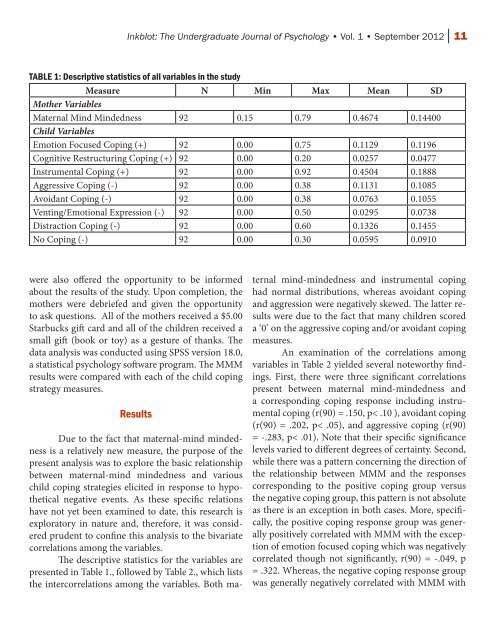7-17-Claire-Banga-Maternal-Mindedness
7-17-Claire-Banga-Maternal-Mindedness
7-17-Claire-Banga-Maternal-Mindedness
Create successful ePaper yourself
Turn your PDF publications into a flip-book with our unique Google optimized e-Paper software.
Inkblot: The Undergraduate Journal of Psychology • Vol. 1 • September 2012 | 11<br />
TABLE 1: Descriptive statistics of all variables in the study<br />
Measure N Min Max Mean SD<br />
Mother Variables<br />
<strong>Maternal</strong> Mind <strong>Mindedness</strong> 92 0.15 0.79 0.4674 0.14400<br />
Child Variables<br />
Emotion Focused Coping (+) 92 0.00 0.75 0.1129 0.1196<br />
Cognitive Restructuring Coping (+) 92 0.00 0.20 0.0257 0.0477<br />
Instrumental Coping (+) 92 0.00 0.92 0.4504 0.1888<br />
Aggressive Coping (-) 92 0.00 0.38 0.1131 0.1085<br />
Avoidant Coping (-) 92 0.00 0.38 0.0763 0.1055<br />
Venting/Emotional Expression (-) 92 0.00 0.50 0.0295 0.0738<br />
Distraction Coping (-) 92 0.00 0.60 0.1326 0.1455<br />
No Coping (-) 92 0.00 0.30 0.0595 0.0910<br />
were also offered the opportunity to be informed<br />
about the results of the study. Upon completion, the<br />
mothers were debriefed and given the opportunity<br />
to ask questions. All of the mothers received a $5.00<br />
Starbucks gift card and all of the children received a<br />
small gift (book or toy) as a gesture of thanks. The<br />
data analysis was conducted using SPSS version 18.0,<br />
a statistical psychology software program. The MMM<br />
results were compared with each of the child coping<br />
strategy measures.<br />
Results<br />
Due to the fact that maternal-mind mindedness<br />
is a relatively new measure, the purpose of the<br />
present analysis was to explore the basic relationship<br />
between maternal-mind mindedness and various<br />
child coping strategies elicited in response to hypothetical<br />
negative events. As these specific relations<br />
have not yet been examined to date, this research is<br />
exploratory in nature and, therefore, it was considered<br />
prudent to confine this analysis to the bivariate<br />
correlations among the variables.<br />
The descriptive statistics for the variables are<br />
presented in Table 1., followed by Table 2., which lists<br />
the intercorrelations among the variables. Both ma-<br />
ternal mind-mindedness and instrumental coping<br />
had normal distributions, whereas avoidant coping<br />
and aggression were negatively skewed. The latter results<br />
were due to the fact that many children scored<br />
a ‘0’ on the aggressive coping and/or avoidant coping<br />
measures.<br />
An examination of the correlations among<br />
variables in Table 2 yielded several noteworthy findings.<br />
First, there were three significant correlations<br />
present between maternal mind-mindedness and<br />
a corresponding coping response including instrumental<br />
coping (r(90) = .150, p< .10 ), avoidant coping<br />
(r(90) = .202, p< .05), and aggressive coping (r(90)<br />
= -.283, p< .01). Note that their specific significance<br />
levels varied to different degrees of certainty. Second,<br />
while there was a pattern concerning the direction of<br />
the relationship between MMM and the responses<br />
corresponding to the positive coping group versus<br />
the negative coping group, this pattern is not absolute<br />
as there is an exception in both cases. More, specifically,<br />
the positive coping response group was generally<br />
positively correlated with MMM with the exception<br />
of emotion focused coping which was negatively<br />
correlated though not significantly, r(90) = -.049, p<br />
= .322. Whereas, the negative coping response group<br />
was generally negatively correlated with MMM with



